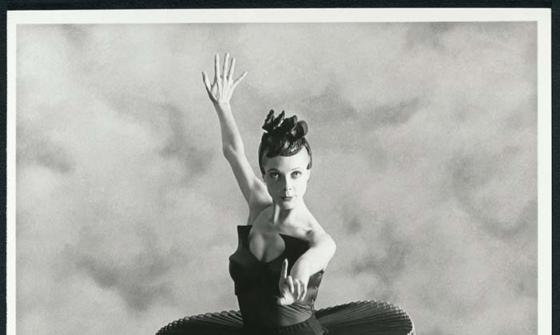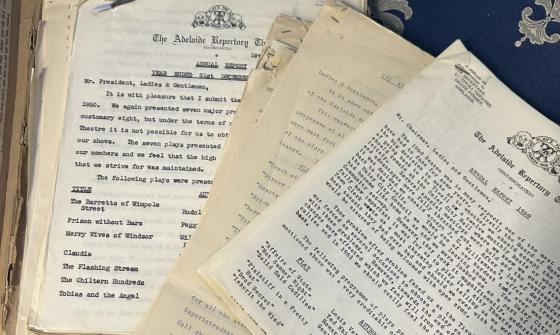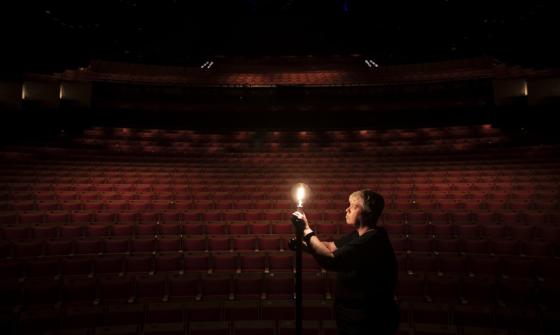Discovery video: The PROMPT collection
The PROMPT Collection forms part of the Library's ephemera collection.
The PROMPT Collection is vast and rich. Within it is a diverse array of performing arts memorabilia including play bills, theatre programs, tickets, commemorative magazines and information about performance venues.
Join Rowan and Philip as they explore a small selection of the colourful and sometimes nostalgic PROMPT Collection.
Discovery video: The PROMPT Collection
R: Hi, my name is Rowan Henderson and I'm a Senior Adviser in the Curatorial at Collection Research section of the National Library of Australia. I'm joined by Philip Jackson, Program Manager in Curatorial and Collection Research.
Welcome to this discovery video in which Philip and I will explore the PROMPT collection at the Library. Philip has worked for the Library's Australian Printed Collections for the last 10 years and he will be sharing some of the PROMPT collection highlights in this video.
The rich culture of Australia's First Nations people has included performance for tens of thousands of years. The National Library of Australia acknowledges these First Australians as the traditional owners and custodians of this land. We give respect to the elders past and present and through them to all Australian Aboriginal and Torres Strait Islander people.
So what is the PROMPT collection? The PROMPT collection is a collection of collections that relate to the performing arts in Australia from the 1880s until the present. It's a part of the Library's ephemera collection, held in a special stack area.
And what's ephemera? Ephemera is printed material that is usually created for a particular purpose and not intended to be kept. In the Library we use the guide that it's usually less than five pages long. It's mostly printed on paper but can also include objects like hats, shirts and badges. It's often printed on flimsy material and can be difficult to conserve.
As the PROMPT collection relates to the performing arts it mainly contains programs but may also include subscription, brochures, flyers, invitations and tickets. Because of their size posters are stored separately, and magazines in the Library's serials collection.
The PROMPT collection is vast, it currently contains 5,269 collections and uses over 300m of shelving. It documents a huge range of topics such as prominent individuals in the performing arts, organisations and groups, venues and performances and it covers genres such as pop, rock and folk music, opera, circus, actors of stage and film, comedians, orchestras, theatre companies and performing art schools. The people and places covered might be known in Australia and around the world or they could be completely local and unknown elsewhere. The performers might not even be Australian but if they performed in Australia they could be in the collection.
Why does the Library collect performing arts ephemera? The Library collects this material so that the Australian community can now and in the future discover, learn and create new knowledge. The Library's role is to develop and maintain a library collection including a comprehensive collection relating to Australia and the Australian people. The Library collects ephemera to document life in Australia, what has happened, where it was and who was involved.
In this case the collection documents the performing arts, to show what has been performed and created in Australia at any point in time, by whom and where.
How does the Library collect it? The Library actively looks for ephemera to collect but also relies on the public and collectors to let us know what is available. We also work with other libraries so that they collect material relevant to their state or territory while we collect items of national interest. If you re a collector and would like to offer items to the Library for this collection you can do so through our website.
So how can you find out what is in the PROMPT collection? The Library has created a handy new finding aid which lists all the collections under headings such as individuals, performances and events, subjects and venues. You can explore it by searching our catalogue for the Guide to the Australian Performing Arts Programs and Ephemera PROMPT Collections in the National Library of Australia. If you're interested in donating ephemera to our collection it would be appreciated if you could check our lists first to make sure we don't already hold the same material. It's also important to remember that there is other material in the Library s collection relating to the performing arts that is not in the PROMPT collection. This material could be found in the manuscripts, pictures and oral histories collections as well as in the Library s extensive collection of books. You can search our catalogue to discover these other collections.
Now Philip is going to take us through some of the highlights of the PROMPT collection.
P: PROMPT is a theatrical term relating to an offstage reminder for an actor or singer of the lines that they have forgotten and although it isn t exactly an acronym it may have been something of an in joke to adopt this term for the National Library s collections of programs and other performing arts memorabilia. Our collection is arranged into mini collections by subject or topic which may be the name of a performer or performing arts company.
The collections range all the way through the alphabet. We have things from A to Z, from Abba to Charles Zwar who was an Australian songwriter, composer, lyricist, pianist, music director who mainly worked in England from the 1930s to the 1960s. He did the music for All Square which is included in this program here and his name is in one of the chequerboards on the front of the program. There may be earlier items but mainly the collection consists of material from the 1880s onwards. In the performing arts exhibition that we've got on at the moment there s a thing by Bland Holt who s one of our most important early performers and impresarios. That exhibition shines a spotlight on the National Library s performing arts collections. There are PROMPT files for Australians who have achieved great fame overseas such as Dame Nellie Melba. In the show there's the 1902 ticket from Melbourne which is her home town where she got her name from and this is a program from the first world war, a charity concert for Polish refugees.
As well as having achieved great fame overseas in London Peach Melba was named after her by the great chef, Escoffier. In America there was even a packet of cigars named after her. So this is a Flor de Melba cigar box, a thing which is probably not a very appropriate thing for a singer. Other performers who feature prominently and on stage are Robert Helpmann and he actually danced in this memorial matinee for Anna Pavlova. He did a duet with a Russian ballerina from Swan Lake and at the other end of his career there s the program for his state funeral where you can find a eulogy delivered by Don Dunstan, the former State Premier of South Australia and a strong supporter of the arts.
Barry Humphries was another Australian who achieved great fame overseas. These are some items from the PROMPT collection relating to an exhibition of her frocks. Cate Blanchett, for her we cover her stage performances rather than her work as a film actor. So Kylie Minogue, we concentrate on her live performances rather than her recorded sound which is really looked after by the National Film and Sound Archive. So this is a program for Cate Blanchett from a performance in New York with David Wenham and this is from Kylie Minogue's 1991 tour. Opera PROMPT files include Dame Joan Sutherland and Richard Bonynge. Dame Joan also had some food named after her. This is a menu from a restaurant in Wellington and there's a spinach fettuccine named after her as well as the dessert at the end of the menu which is called La Stupenda which was her nickname. As well as programs we have all sorts of material so there were also some stamps issued to honour Dame Joan a few years ago as well.
There are other opera companies in the collection as well as Opera Australia, the big company so there s the Pinchgut Opera which is a smaller opera company that concentrates mainly on baroque music so this is a program of work from 1778 which they performed for a rare time in Sydney in 2015. Ballet programs, we have things from Ballet Russe who were one of the first big ballet companies to tour Australia in 1936. The Borovansky Ballet Borovansky came from overseas but stayed in Australia for a long time and did much to establish Australian ballet. Australian Ballet, we've got programs here on display from the early 1960s and then 2000. This is a program honouring Graeme Murphy. There are things from Bangarra as well, the Aboriginal dance company. In the exhibition there s a full size copy of the poster for this program, Praying Mantis Dreaming with a wonderful part by Libby Blayney and then there s a much more recent program there for Skin which is a program by Bangarra that examines family kinship. Australian theatre has a huge range of material in the PROMPT collection. We've only got one program here on display which is the Bell Shakespeare Company s first production of Hamlet in 1991. The Tivoli Theatre was a big circuit. It was linked to JC Williamson who was known as The Firm. They were a huge company that was set up in 1882 and they ran theatre pretty much in Australia until 1976.
These two programs here are from 1939 and they brought in people like Anna May Wong who was an actress from Hollywood and the Mills brothers who were African American singers. The Tivoli also in the 1940s and 50s were a lot more risque than you might expect from that conservative period. There are programs with chorus girls and can-can dancers and that sort of thing. We've got musicals such as Jesus Christ Superstar.
There's a program from 1972 with a ticket. Instead of Phantom of the Opera well we do have that as well, we've got Phantoad of The Opera which was a Brisbane parody of it from 1991. Wicked, a modern play and of course Tim Minchin's Matilda on display in the On Stage exhibition. There's material related to traditional circuses such as Ashton's who were established in 1932 and this particular program has a little caption on it "Col and I went in 1967 and it was a very good show " so programs can be mementos of a performance with a personal touch. More recently a more modern circus is Circus Oz. This is a program from their seasons in the early 1990s. Circus Oz don't include any animals in their circus but there are animals in the performing arts collections such as Topsy who was a performing horse who could count, identify colours, play cards, do magic tricks. Topsy toured eastern Australia performing mainly in the Gold Coast region in the early 1950s. This little item indicates that she gave command performances for horse lovers like Queen Elizabeth and Prince Philip in 1952, '54 and the Queen Mother in 1958.
There are also performing arts events for festivals, Adelaide Festival. That's from the first one in 1960 and then there's the Garden of Earthly Delights from the Adelaide Fringe Festival from only a few years ago and the National Folk Festival. There's a poster from that in the On Stage exhibition and in the PROMPT collection there s a media kit for the 50th anniversary of the festival in 2016 so the festival started in 1967.
The PROMPT collection contains a huge range of highly significant, evocative, beautiful and fascinating material and whatever your personal interests may be there is probably something in it that will amuse or entertain you.
Visit us
Find our opening times, get directions, join a tour, or dine and shop with us.



